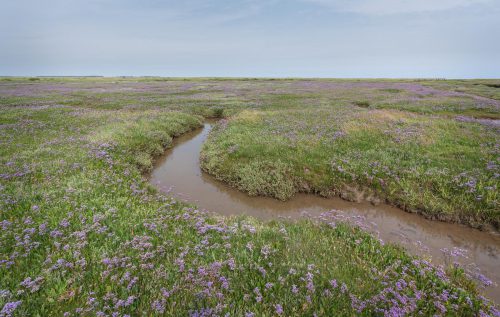For a month or two each year, something quite special happens on the coastline around the UK and specifically in abundance on the Suffolk and Norfolk coast. It is of course, sea lavender. Those that have photographed it before will know what a sight it is and for those who haven’t, I’ll provide you with some tips and hints so you can experience it for yourself and hopefully get some amazing photos.
About Sea Lavender
Sea lavender can be found around the British coastline and grows on mudflats and salt marshes. It roughly flowers July to September depending on location and growing condition and most commonly produces a lovely pastel purple colour. Surprisingly sea lavender is not actually related to lavender and so does not have that distinctive smell. You will however still see plenty of bees hovering around the sea lavender, collecting nectar, just like lavender.
Where to Find Sea Lavender (in Norfolk)
It’s found in pretty much all of Norfolk’s saltmarshes which are primarily concentrated on the North Norfolk coast. The sea lavender on the stretch of coastline between Cley next the Sea and Thornham is excellent and you’ll find it everywhere. Blended with the idyllic and photogenic fishing villages in the area, it really is an excellent location for landscape photographers.
My two favourite locations are probably Stiffkey and Thornham Old Harbour but I would strongly recommend exploring a few locations while you’re in the area.
I find late July tends to be the optimum time, although this can vary from year to year. Like any other flower, as soon as it blooms is when it’s the most vibrant and colourful.
Photographic Tips on Shooting Sea Lavender
1. Look for pools in the salt marshes to add a focal point
On the salt marshes you’ll find plenty of small pools and areas that collect the tidal water. Some are bigger than others but I find the smaller ones add more interest from a photographic perspective and generally you’ll find the sea lavender is more populated here compared to the larger pools. In the height of summer, you’ll come across pools that have completely dried up with cracks appearing in the mud. The cracks add so much texture and depth to the image and add a really interesting element to your photo. You won’t find the dried pools everywhere though.
2. Look for twisting creeks as leading lines
Something else you’ll find on the salt marshes is twisting and curving creeks formed by the tide. They add nice interest to the image and it helps the viewer ‘navigate’ their way through the scene. The salt marshes are a bit barren and unless you have an amazing sunset/sunrise a background element is hard to come by. Focusing on the elements in the foreground is however a good alternative.
3. Use man-made structures to your advantage
Often you’ll find bridges used to cross streams or to navigate the muddier sections of the marsh. This is particularly the case at Stiffkey, Norfolk, as there’s a series of bridges allowing you to reach the beach. These bridges add interest to your composition and can balance your image well. I do find however, some of the bridges are more photogenic than others. I also find these compositions rarely work if there’s too much mud surrounding the bridge. The further you walk however the less muddy the area surround the bridges gets.
4. Don’t forget the harbours
Often I find some of the best distribution of sea lavender is actually located close to the harbour. The added benefit of searching in this area is you’ll likely come across plenty of boats laid up. This will add a much-needed focus to your image. If you’re also pressed for time (chasing a sunset for example) it comes in handy thinking of places that are close to the car park and is easy to reach.
5. Go out in all conditions
Something we’re all guilty of once in a while is only going out with the camera in the best conditions or at certain times in the day. More and more I try to go out in all conditions, particularly when it’s dull and overcast. Not only do you have to work harder to find a composition, but it also allows you time to scout locations and come back when you do have those ideal conditions.
6. Bring your wellies!
The best tip… saved until last.
A tip not just for photographers, but anyone thinking of visiting the salt marshes. The clue is in the name, the mudflats. It obviously gets very muddy, in the winter and in the summer. You’re guaranteed to see tourists and holidaymakers making the same mistake of wearing their best trainers or hiking boots, only for them to be covered in mud moments later. Not only does this ruin your shoes and gives you wet feet but you’ll miss out on exploring the marshes by walking further afield. For photographers this is key and you don’t want to miss that shot all because you forgot to wear your wellies.
Final thoughts…
Personally I find sea lavender a highlight of the year and I love how it completely transforms a barren landscape into one that is full of colour and life. Photographically speaking, sea lavender is great as well. The colours are not too vibrant and can be edited well (It’s quite hard to oversaturate). Find unique compositions is also plentiful and allows you to get creative. Finally, chances are the salt marshes will be the quietest place during the height of the holiday season, having it to yourself to enjoy.





